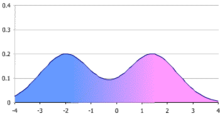
Back Distribució multimodal Catalan Distribution multimodale French 다봉분포 Korean Мультимодальний розподіл Ukrainian 雙峰分布 Chinese




In statistics, a multimodal distribution is a probability distribution with more than one mode (i.e., more than one local peak of the distribution). These appear as distinct peaks (local maxima) in the probability density function, as shown in Figures 1 and 2. Categorical, continuous, and discrete data can all form multimodal distributions. Among univariate analyses, multimodal distributions are commonly bimodal.[citation needed]
© MMXXIII Rich X Search. We shall prevail. All rights reserved. Rich X Search